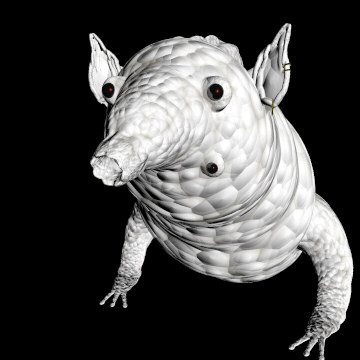
 |
|||||||
|
|
|
|
|
|
|
Coman |
 |
|||
Homeworld: |
Coman, Sector 2 (Beta Coma Berenices IV) | |||
Ecology: |
Nitrogen-Oxygen-Water | |||
Biology: |
DNA I | |||
Languages: |
Coman | |||
Human Contact: |
2204CE | |||
FTL Status: |
n/a - protected non-technological race | |||
Current Status: |
Unofficially protected by the Terran Khalifate and the League of Independent Races | |||
Environment |
Ideal |
Tolerance |
||
Atmosphere: |
.19B O2 | .13-.25B O2; CO2 < .05B | ||
Temperature: |
275K | 250-290K | ||
Gravity: |
1.03G | .5-1.2G | ||
Other: |
Humidity 50% | Humidity 02-99% | ||
The Comans were the first intelligent species contacted by Humanity. Despite considerable intellect, the Comans have remained pre-technological for their entire existence, rejecting tools or artifacts that cannot be constructed by hand out of natural materials. Comans remain limited to glacial interface regions of their homeworld. If not for their history as the first intelligent race encountered by Humanity and for their earlier encounters with Grand Federation races, they would be no more significant than any of the thousands of non-technological intelligence races that reside within Known Space.
Comans are white or pale pink slug-like creatures. At adulthood, they mass over two thousand kilos and reach a length of five meters. One end of the body ends in a head that tapers to a conical snout. The snout protects concentric rows of grinding "teeth", which help the Comans burrow through snow and ice and it filters the microscopic snow organisms that form the Comans' diet. The snout also holds olfactory sensors, but is not responsible for respiration. A hardened fleshy hood at the back of the head is the Coman's respiratory and vocalization organ, allowing breathing and communication while burrowing through ice and snow. The Coman head contains four reddish eyes that allow excellent depth perception, but only distinguish red and near-infrared frequencies. Distance vision is poor. Two large "pig-like" ears dominate the side of the head.
A Coman's large tubular body contains no skeletal structure, just a mesh of hardened cartilage-like sacks covered by a knobby insolating skin. Comans have only two limbs, arms ending in flexible three-fingered hands. The tips of Coman fingers have flat pads that allow considerable cohesive power, though far from enough to support the full mass of an adult Coman - however, juveniles have been known to climb and hang from sheer cliffs using their finger pads. The Coman body ends in a tapered cone, containing the anus, sexual organs and additional olfactory sensors.
Comans do not wear clothing, though they often wear ear rings fashioned from the ring-like bones of snakeworms. Leaders within a Coman community sport tattoo-like emblems to signify rank and accomplishment.
Comans are the largest life forms on their world. They form cooperative groups (clans) of several dozen related individuals to build tunnels complexes in search of concentrated veins of microbial food. Coman sexual characteristics are based on environmental and hormonal factors, with only a few individuals within the clan developing a distinct gender at any one time. Courtship is a highly ritualized activity, involving the entire clan. After fertilization, the Coman fetus remains inside a sack in the female's anal cavity for only twenty-seven days, emerging as a small pink grub, only three to five centimeters long. The clan's juvenile Comans care for young grubs, who take adult form and hue after one Coman year (510 standard days). These yearling juveniles are less than one meter long and mass only thirty to fifty kilograms. A Coman remains in juvenile form, cared for by older juveniles, reaching adult size after twelve local years. After juvenile life, a Coman enters and apprentice phase, adopted by a small group of adults and taught skills such as tunnel prospecting, weather lore or artistry. All apprentice Comans also learn to sing the epics that form the basis of Coman communication.
After an apprenticeship of six Coman years, the Coman becomes a full member of the clan and a practitioner of its studied trade. Comans generally remain with their clans for life and clans remain fairly stable in population. Coman life expectancy is approximately eighty local years, but full life span is considerably longer, with some individuals living for nearly two hundred years.
Coman history is strictly an oral tradition, a subsets of the epic songs of the clans. Reconciling the songs with archeological evidence and Grand Federation records reveals that the historical epics remain extremely accurate representations of Coman history. Comans evolved over eight hundred thousand standard years ago on the margins of the southern polar ice fields. They represent the last surviving species of a class of large semi-aquatic life forms that lived in and around the high tundra seas and lakes near the world's extensive glaciers. A spike in global temperatures caused rapid glacial retreat and flooded coastal regions, devastating much of the larger fauna of Comans. The "Song of Rushing Water", a creation myth evident in all Coman subcultures, records this ecological crisis and the resultant beginning of Coman oral history. Within one hundred thousand years, the climate returned to normal, and, as recounted in the "March of the Icewalls", the glaciers returned.
Comans retained a static culture for the next several hundred thousand years, eventually occupying the ecological niches of their ancestor species and colonizing their world, living a semi-nomadic life in the large seasonal boundary zones of both polar caps. Coman population stabilized at nearly two hundred million individuals and distinct subcultures and languages began to emerge. Warfare was anathema to the Comans and murder or violence remained the extremely rare anomalies of insane individuals.
Coman culture was hardly impacted by the arrival of Founder and later Grand Federation research teams. Though small bases persisted from 60,000BC until 800CE, this contact had little affect on Coman society, though the stories of the Sky Peoples wove themselves into the songs of those clans that had contact with the bases. Human contact began in 2204CE, and continued throughout the Confederation Era, though strict rules on interference limited contact to a few isolate clans who were not necessarily representative of the entire culture. A few Coman individuals traveled off world with the Humans, but all became increasingly forlorn without the presence of their clan mates and soon returned to their ancestral homes. The Comans showed no interest in acquiring technology, though they often expressed interest in understanding how equipment functioned.
The Empire of Humanity formally recontacted the Comans and admitted them as a Minor Race in 2795CE, but the Comans expressed little interest in changing their culture, adopting technology or leaving their world. However, more extensive contact with Human scientists and activists did eventual influence Coman culture. During the long Imperial Era, the Comans learned improved healthcare technique and adopted a new profession: the doctor. By the end of the Imperial Era, the Coman population had increased to nearly eight hundred million and increased contact between clans had established a common Coman language. The cultural homogenization resulted in the loss of many thousands of songs.
The Comans barely noticed the collapse of the Empire and the Wars of Disintegration. The Mech Plague did not affect them. The world of Coman was uncontacted for many centuries and when contact resumed, the Terran Khalifate effectively quarantined the world. The League of Independent Races established an embassy and research facilities on Coman in 6295CE.
The Comans retain a static non-technological society, little changed for hundreds of thousands of years. The population, increased by the introduction of doctors, remains steady at just more than six hundred million individuals, close to the maximum sustainable number in their ecosystem.
Comans remain willing to interact with visitors and are eager to share their songs with outsiders. Comans remain very friendly towards Humans and generally consider them to be their protectors. Few Comans ever leave their world, and even fewer remain away for more than a few local years.
All pages and images ©1999 - 2006
by Geir Lanesskog, All Rights Reserved
Usage Policy
![]()